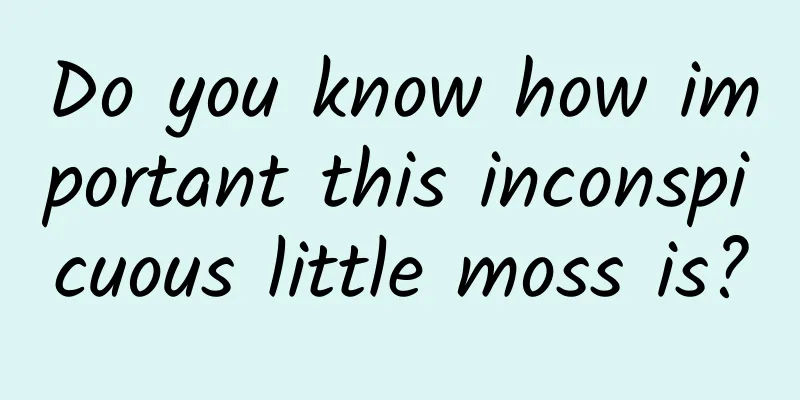Do you know how important this inconspicuous little moss is?

|
Disclaimer: In accordance with general ecological survey practices, the locations and plots in this article have been blurred to avoid bringing unnecessary crisis to endangered species. The places we often go to for scientific research are in the mountains of the southwest of our country. We often don’t see many living people all day. But one time, we were squatting beside a rugged dirt road, taking pictures and collecting moss, and suddenly a group of suspicious people came... With a few shouts, a team of horses rushed over the dirt road, which was not very wide to begin with. Each horse was carrying seven or eight bags of stuff. The road was narrow but the cargo was wide, so we had to stop what we were doing and stand up to make way for them. The people driving the horses had eyes that were hard to read. We whispered to each other, wondering what was in the sacks? Wild vegetables? Chinese medicine? Could it be drugs? Would they kill us? You must be kidding. How could they use sacks to make such a desperate living? Suddenly, one of the team members saw some of these things exposed outside and thought they looked familiar. So he took advantage of the time when the horse team was moving forward and took a small handful of them. When he got closer, he saw that they looked familiar. They were the mosses we were investigating. The team leader identified them and found that they were most likely the multi-lined sphagnum mosses that were just included in the "List of Key Protected Wild Plants in China" last year . We felt very sorry that the dozens of sacks transported by the horse team would destroy a lot of sphagnum mosses. Some of you may not understand the situation. What? Don't all mosses look the same? And they are everywhere, so why are they on the key protection list? If mosses are on the list, doesn't it mean that if you pick them casually, you may accidentally harm protected plants and end up in jail for a few years? In fact, the mosses that have been protected are not the ordinary mosses on the roadside. They all have their own tragic stories and were forced to be included in the protection list. Among these mosses that have been protected, the peat moss family occupies two places. Today we will focus on their stories. 01 What is the relationship between moss and orchids? The story of peat moss begins with orchid cultivation. We all know that orchids are elegant and beautiful, and many varieties are expensive, so how are they grown? This is where moss comes in. Peat moss is widely used in the cultivation of orchids and many other plants. In gardening, it is more commonly known as "sphagnum moss." Because it has the characteristics of water retention and air permeability, and peat moss itself produces bactericidal substances, it has a good protective effect on plant roots. It is really an excellent planting medium for those delicate gardening plants, and the consumption of peat moss in the cultivation of orchids is second to none. Sphagnum moss used to grow orchids | Photo provided by the author It is for this reason that the market demand for peat moss is very huge. In addition to importing from abroad, people have also found this type of moss growing in the wild in China, so merchants buy wild peat moss from villagers at low prices, and even sell wild peat moss overseas. Such commercial over-exploitation has successfully dug the two types of peat moss into the protection list. We decided to follow the direction of the horse team to look for wild peat moss, which is a rare moss plant on the protection list. After walking through the mountain road, there is a vast grassland with a clear view. The spring water in the distance flows down from the top of the mountain, accumulating water on the flat meadow, leaving small pools. When we get closer, as expected, there are patches of peat moss growing in these pools, with branches close to each other, like water-moistened grassland. This is a small piece of veritable and relatively healthy peat bog. Sphagnum moss swamp | Photo provided by the author However, these peat mosses are not the coarse-leaved peat mosses and multi-veined peat mosses on the protection list, but relatively common species, and it seems that peat moss dealers are not interested in them. The peat moss species is smaller in size and not as thick as the other two species, which are more suitable for gardening. They live comfortably here, escaped a catastrophe, and enjoy this tranquility with other aquatic plants. 02 Peat moss and water The growth method of peat moss is very unique. Mosses have no root system, and they almost only use leaves to absorb water and nutrients from the environment. Therefore, for them, without roots, they can grow upward without any care, and the lower part of the plant has no value and dies. After years of accumulation, the dead plants below are slowly and inadequately decomposed under anaerobic conditions, accumulating sufficient humus, which is the source of part of the peat soil. These soils are rich in carbon and can even be used as fuel after drying, which is why peat moss is called "peat". Sphagnum moss soaked in water | Photo provided by the author Although this kind of peat moss does not have much gardening value, it is extremely important to the ecological environment. Whether it is a dead plant that has not yet decomposed or a living plant, peat moss can absorb 10-30 times its own weight in water. This secret is hidden in their leaf cells. Leaves of peat moss under a microscope | Photo provided by the author When we put their leaves under a microscope, we can see that their water storage cells and photosynthesis cells are arranged in an interlaced manner. The water storage cells are very large, and these cells enable them to store sufficient water. This characteristic is for the environment, especially for this swamp, they are like small living reservoirs that accumulate water. During the rainy season, the rain will not flood and wash away the fragile meadow soil. And it can maintain a certain degree of moisture in a relatively dry climate. Cross-section of a peat moss leaf | Image from the author It was raining when we arrived at this area. The peat mosses in this area were fulfilling their mission in the ecological environment. Only the water was flowing slowly downwards, slowly nourishing the land and the plants on the grassland. 03 Peat Moss and Soil After collecting the specimens of peat moss, we looked around and found that this area was indeed a good place for feng shui, but all around were the same kind of moss. We continued to search along the stream and finally found another type of peat moss that was even thicker beside the stream. Based on the difference in the shape of their leaves (leaf tips facing backwards), we thought it should be the coarse-leaved peat moss on the list. It was great that we successfully harvested a kind of protected moss. Their habitat is also slightly different. They only grow on the soil wall of the stream, not on a "lawn" as before. The water flow here is relatively fast, and only some of the coarse-leaved peat moss is immersed in the water, while some of them extend their branches and leaves to the water, absorbing the "passing" water. This growth method is too tricky and really tests our shooting ability. We had to step into the cold stream water and try to give them a beautiful close-up. Rough-leaved Sphagnum moss | Photo courtesy of the author The stem and leaf structure of peat moss is complex. During the growth of the straight stem, several side branches are continuously branched out. The side branches at the top are very dense, like a mini cauliflower. The leaves are also closely attached to the main stem and side branches. Such a structure can buffer the flow rate of water to a certain extent, and can also buffer the "attack" of water on the soil to a great extent - at least for the soil "under the feet" of peat moss, this is a lot of help, otherwise the shore in front of us may be a barren scene eroded by the stream - the soil is constantly peeling off, and it is difficult for plants to grow on it. Peat moss in different environments also has different functions. We wandered around the vast grassland for a long time, looking for every small pool and swamp along the way, but we couldn't find where the multi-striped peat moss that the villagers carried on horses grew. In the end, we only found a small house where the villagers temporarily stored peat moss. The peat moss that was full of water was heavier and easier to transport after drying. This should be the place where they dried and transferred it. There were dozens of sacks of peat moss piled up inside, and they would be brought up and carried down by horses later. Maybe the merchants who bought it were waiting at the foot of the mountain to buy it from the villagers. We could only get a little from the sacks as specimens and evidence of local communication and suggestions. Can we only take from the natural environment? Or do we have to give up using peat moss, an excellent planting substrate? Not really. In fact, there are relatively mature peat moss planting technologies at home and abroad. The requirements for peat moss are very simple, not too hot and sufficiently humid environment, preferably with a piece of standing water. You only need to fill the ditches in the fields where other crops or herbs were originally planted with water, exposing part of the ridges for planting peat moss. There is no need for fertilization or pesticides, which are so troublesome to manage. In just a few months, the peat moss can be harvested. But what are the consequences of continuing to dig wild peat moss? Ravines washed out by floodwaters | Photo provided by the author On our way back, we took another route and found a gully that had ruthlessly torn a huge hole in the meadow, like a narrowing canyon. The soil on both sides of the gully was still slowly falling to the bottom of the gully, leaving only a shallow stream at the bottom of the gully. We speculated that a large flood had occurred here, widening and deepening the original river channel. There were no trees on the grassland, and no plant roots deeply rooted in the soil, so the soil here was very fragile and could not withstand a large flood. Perhaps this situation has something to do with the destruction of vegetation and the over-exploitation of peat moss. Author | Review | Wang Kang Director of Beijing Botanical Garden Science Center Professor-level Senior Engineer Editor | Ding Zong This article is produced by the "Science Rumor Refutation Platform" (ID: Science_Facts). Please indicate the source when reprinting. The pictures in this article are from the copyright gallery and are not authorized for reproduction. |
<<: Heavy rain and rainstorm are coming today →
>>: Will drinking edamame cause bone deformation? These things are the culprit
Recommend
November 2023 "Science" Rumors List: Can you change the medicine for treating mycoplasma pneumonia yourself? Is skim milk healthier?
1. You can change the medicine by yourself for th...
Why Apple paid $3.2 billion for Beats
Apple is about to make its biggest acquisition in ...
Who is more likely to share fake news?
Who is more likely to share fake news? © Getty Im...
Fruit freedom is difficult now, and it was even more difficult before
This article is excerpted from "The Code of ...
Jurassic World 3 is released, and the top Mosasaur is criticized for not appearing enough?
Breaking news: There’s a new movie in the “Jurass...
The girl was crushed after being "killed by opening the door"! It is not advisable to open the door like this
Recently, the news that a child in Tianjin was ki...
Do you sleep well because of snoring? This disease not only affects your sleep, but may also cause these harms
Sleep apnea syndrome is a common sleep disorder t...
Activities, teams, promotions, tools, guaranteed to be the most comprehensive new media operations guide you have ever seen!
The rise of mobile Internet has made the college ...
What are the charges for 400 calls?
How to apply for a 400 number. There are two opti...
Weilai delivers more than 10,000 cars this year. He Xiaopeng is willing to admit defeat: ES8 purchase money will arrive soon
Yesterday, NIO just announced that the delivery v...
Changan Mazda MAZDA EZ-6 sets new value standard for new energy joint ventures, makes global debut at Beijing Auto Show
On April 25, Changan Mazda's first electric s...
An introduction to Yidian Zixun platform and a display of advertising cases!
Platform Introduction Yidian Zixun is an interest...
“Live streaming with goods” does not require internet celebrities!
However, even though it’s still “making friends w...
Even if Apple comes, it won’t work. Why is the experience of in-car operating systems far inferior to that of mobile phones?
We are in contact with operating systems all the ...
Analysis of AARRR (user growth) model: How to achieve user growth?
This article starts from the experience and expla...









